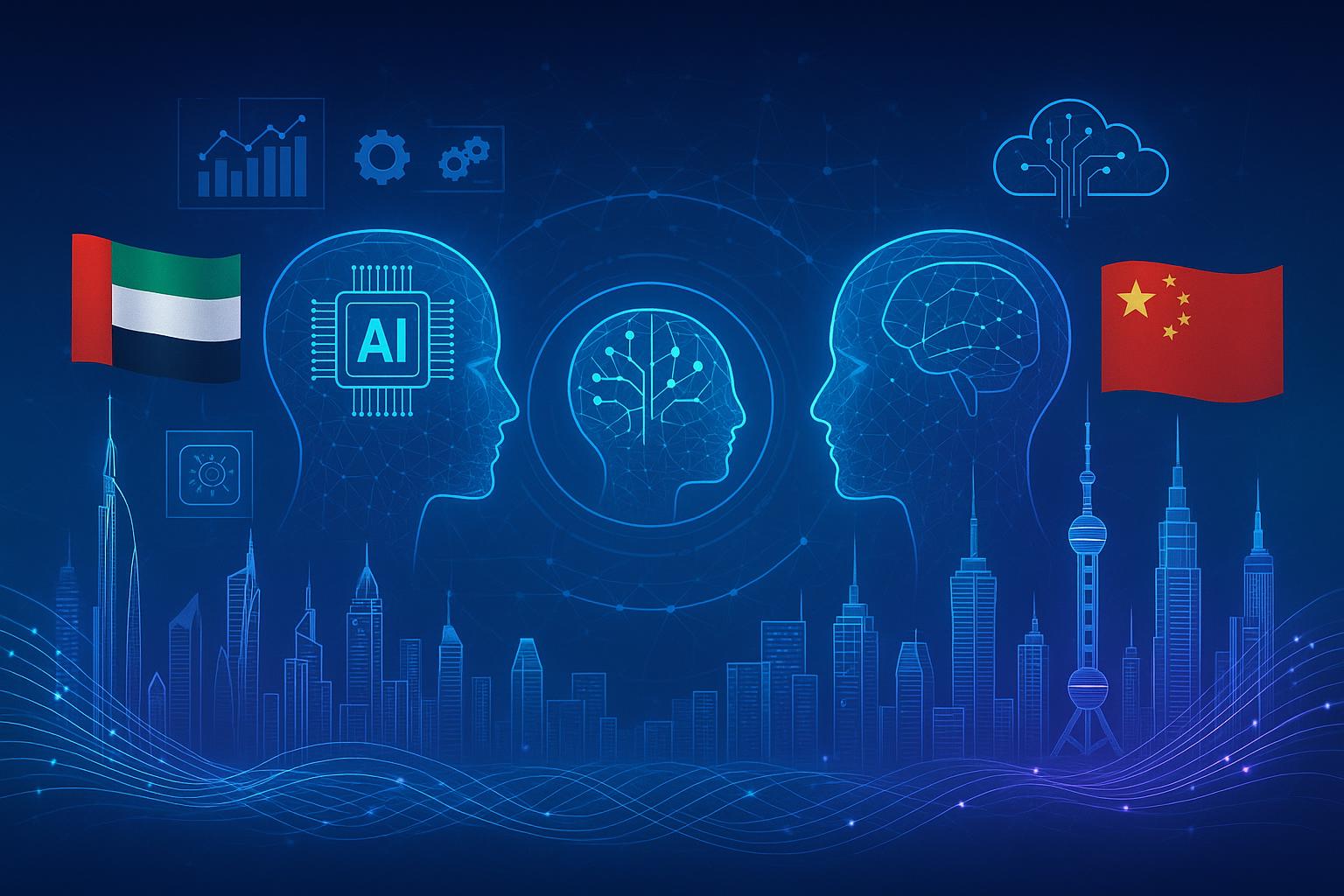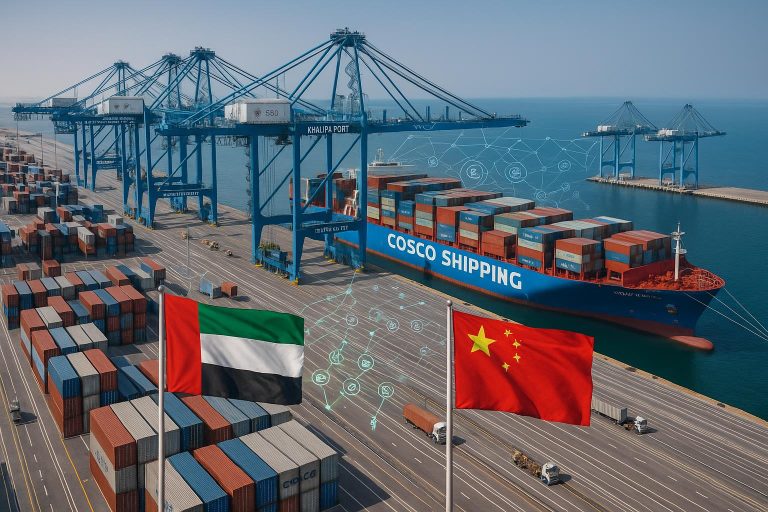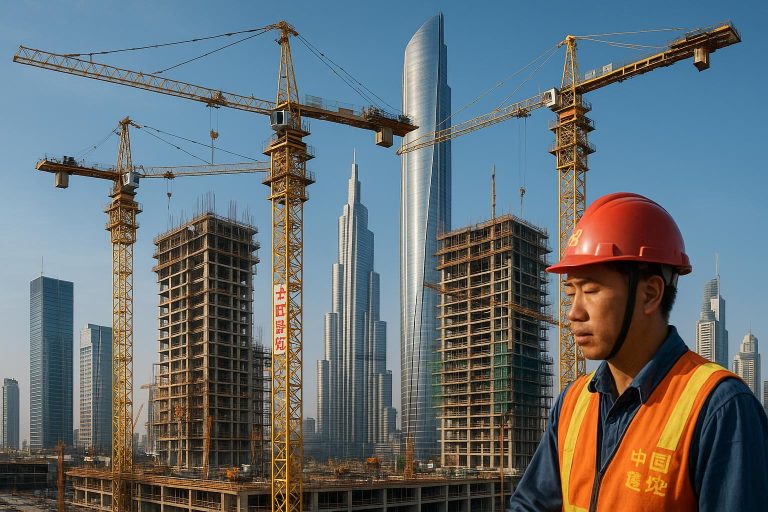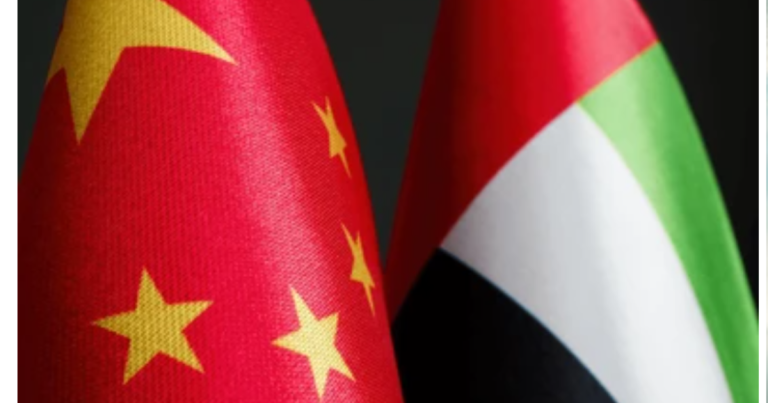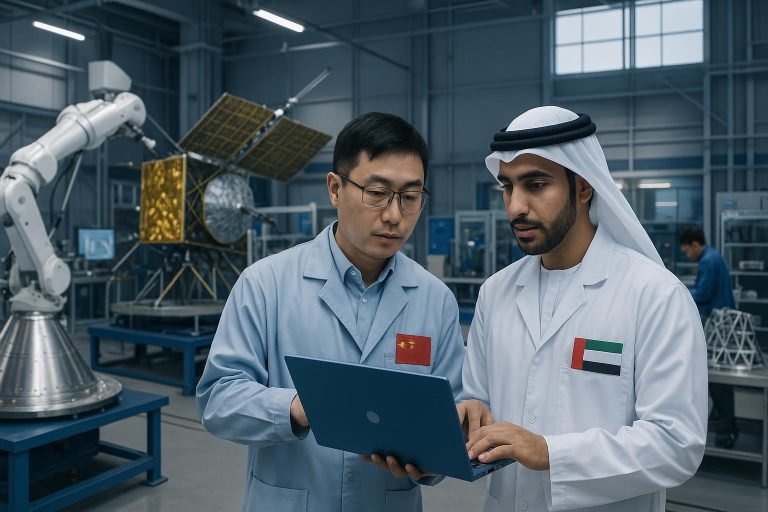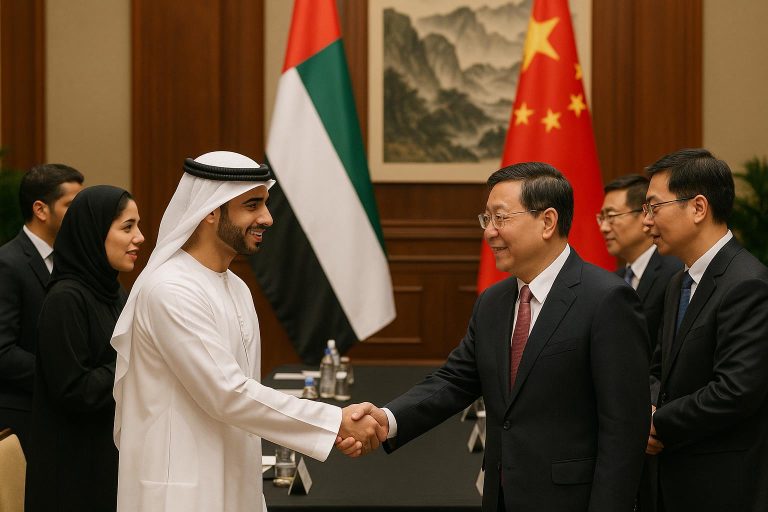Forging the Future of AI: The UAE-China Partnership in Artificial Intelligence and its Global Implications
Executive Summary
The strategic partnership between the UAE and China is rapidly evolving, with Artificial Intelligence (AI) emerging as a pivotal sector for collaboration. This article explores the multifaceted dimensions of this partnership, highlighting its significant growth and global implications. Driven by a shared vision for technological advancement and economic diversification, both nations are investing heavily in AI research, development, and application. The UAE, a digital transformation hub, serves as a crucial base for Chinese AI firms, while China offers advanced technological expertise. This collaboration extends beyond economic benefits, influencing global AI governance and technological landscapes. Despite challenges, synergistic AI efforts are poised to redefine industrial capabilities, foster innovation, and establish a new paradigm for international cooperation, offering a positive yet critically analytical perspective.
Introduction
The 21st century is defined by rapid technological advancement, with Artificial Intelligence (AI) at its forefront. As nations vie for leadership, the partnership between the United Arab Emirates (UAE) and China has emerged as a compelling case study of strategic collaboration. This article delves into their burgeoning alliance, examining joint ventures and shared ambitions in AI. The UAE, diversifying its economy and aiming to be a global innovation hub, finds a natural partner in China, a global AI leader. This synergy represents a deeper convergence of strategic interests, leveraging AI for sustainable economic growth, societal progress, and enhanced global influence. We will explore their bilateral relations, current AI cooperation, opportunities, challenges, and the profound global implications of this evolving partnership.
The Current Landscape of Bilateral Cooperation
The UAE-China relationship has matured into a comprehensive strategic partnership, characterized by robust economic ties and expanding collaboration. Bilateral trade reached a record $101.8 billion in 2024, an 800-fold increase since 1984. The UAE is China’s largest export market in the Middle East and its second-largest regional trading partner, while China remains the UAE’s largest trading partner. Over 15,000 Chinese firms operate in the UAE, and UAE investments in China reached $4.5 billion by the end of 2023, a 96% increase from the previous year.
This strategic framework is supported by the UAE-China Investment and Economic Cooperation Working Group and regular high-level diplomatic engagements. While traditional sectors like energy and infrastructure remain strong (e.g., COSCO terminal at Khalifa Port, China-UAE Industrial Capacity Zone), focus has shifted to new economy sectors. The UAE’s role as China’s Gulf gateway is solidified through logistics collaborations, such as JINGDONG Property’s first Middle East logistics hub in Dubai and JD.com’s smart supply chain technologies implementation.
Artificial Intelligence and Digital Transformation are critical pillars. Both nations recognize AI’s potential for economic diversification and global competitiveness. The $5 billion partnership between the UAE and China for AI, renewable energy, and infrastructure highlights this commitment. Companies like G42 in the UAE strategically position themselves at the nexus of global AI development, engaging with both Western and Eastern markets. Digital Dubai’s exploration of AI and smart city technologies in Shenzhen further illustrates the UAE’s proactive approach. This cooperation extends to practical applications and knowledge exchange, with Abu Dhabi as a primary investment hub and Dubai crucial for trade facilitation. The shared vision is to harness AI investments for domestic advancement and global influence, making this collaboration a significant force in shaping the future of technology.
Opportunities and Strategic Growth Drivers
The UAE-China AI partnership is underpinned by a confluence of strategic opportunities and powerful growth drivers, positioning both nations for significant advancements in the digital economy. A primary driver is the shared commitment to economic diversification and technological leadership. The UAE’s national AI strategy, coupled with its vision to become a global innovation hub, aligns seamlessly with China’s ambitious AI development plans, including its goal to be a world leader in AI by 2030. This alignment has materialized in substantial joint ventures, such as the $5 billion partnership dedicated to AI, renewable energy, and infrastructure, signaling a long-term commitment to high-tech collaboration.
These strategic growth drivers manifest across several key areas. Firstly, Cross-Sectoral AI Integration is a significant force. AI acts as a transformative catalyst across diverse sectors. For instance, in healthcare and pharmaceuticals, the acquisition of UCB Pharma’s mature business in China by the UAE’s Mubadala signals a broader interest in medical technology and pharmaceutical partnerships, where AI can significantly optimize drug discovery, diagnostics, and patient care. Similarly, in agriculture and food security, projects like the Silal and China’s Shouguang Vegetable Group’s $33 million smart agricultural initiative leverage AI for advanced hydroponics and modern agricultural technologies, enhancing food production efficiency and sustainability.
Secondly, Infrastructure and Logistics Enhancement benefits immensely from this partnership. The UAE’s strategic geographical location and advanced logistics infrastructure position it as an ideal partner for China’s Belt and Road Initiative (BRI). AI-driven solutions are crucial for optimizing supply chains, port operations, and smart warehousing. The establishment of JINGDONG Property’s first Middle East logistics hub in Dubai and the implementation of JD.com’s smart supply chain technologies exemplify how AI is being integrated to streamline trade flows and reinforce the UAE’s role as a critical logistics hub for China-Middle East trade.
Thirdly, Digital Transformation and Smart City Development are central to the collaborative efforts. Both nations are heavily invested in comprehensive digital transformation agendas. The UAE, particularly through initiatives like Digital Dubai, actively explores AI and smart city technologies, drawing valuable insights from innovation hubs such as Shenzhen. This collaboration extends into critical areas like financial services and fintech, where partnerships such as China’s CIPS and the UAE central bank cross-border payment cooperation and Abu Dhabi-China fintech collaborations are leveraging AI for secure, efficient digital transactions, including through ETF launches and cross-border payment connectivity programs tailored for the MENA region.
Fourthly, the fostering of an Innovation Ecosystem and Talent Development is a key driver. The UAE is proactively cultivating a vibrant innovation ecosystem designed to attract global talent and stimulate research and development. Chinese AI companies find a highly supportive environment within the UAE’s free zones and investment hubs, particularly in Abu Dhabi. This mutual exchange of expertise and investment significantly accelerates innovation. The G42 group, for example, strategically positions itself as a bridge between the US and China markets, showcasing the UAE’s pivotal role in facilitating global AI advancements and serving as a platform for international talent.
Finally, Aviation and Transportation Advancements are being revolutionized by AI. The future of transportation is increasingly intertwined with AI capabilities. The landmark $1 billion deal for 350 flying taxis (eVTOL aircraft) between the UAE and China represents a bold leap into advanced urban mobility, a sector heavily reliant on AI for navigation, safety, and operational efficiency. This initiative, alongside the Emirates and Air China’s MoU for enhanced partnership and route expansion, points towards a future where AI optimizes aviation logistics and significantly improves the passenger experience.
These opportunities are further amplified by consistent high-level visits and diplomatic engagements, fostering trust and facilitating multiple MoUs. The focus on new economy sectors, entrepreneurship, and tourism (including the 2025 China-GCC tourism trade fair in Dubai and China Tourism Group exploring UAE hospitality sector investments) creates a fertile ground for AI applications to enhance efficiency, personalize experiences, and drive growth. The strategic alignment and complementary strengths of the UAE and China are thus creating a powerful synergy, driving forward the future of AI with global implications.
Challenges and Critical Considerations
While the UAE-China AI partnership presents immense opportunities, it faces challenges requiring careful navigation. The geopolitical landscape, particularly the US-China technological rivalry, necessitates the UAE to balance strategic partnerships to avoid broader tensions. This demands a nuanced approach to technology transfer, data sharing, and infrastructure development, ensuring national security while fostering innovation. Entities like G42 exemplify this delicate balancing act.
Data governance, privacy, and security form another critical area. As AI systems integrate into critical infrastructure, concerns arise regarding data sovereignty, privacy protection, and cybersecurity. Establishing robust legal frameworks and technical safeguards aligned with international best practices is paramount for responsible AI development. Harmonizing differing regulatory standards between the two nations will be crucial.
Ethical considerations in AI development also demand close attention. Both nations must collaborate on ethical guidelines addressing algorithmic bias, transparency, accountability, and societal impact. Ensuring AI development serves humanity and upholds fundamental values is a shared responsibility. Lastly, the talent gap and intellectual property protection remain ongoing challenges. Attracting and retaining top-tier AI talent, alongside safeguarding intellectual property rights, are vital for sustainable growth and preventing disputes. Proactively addressing these considerations is key to the long-term success of the UAE-China AI collaboration.
Case Study Spotlight: G42 and the Global AI Landscape
A compelling illustration of the UAE-China AI partnership in action is the Abu Dhabi-based AI and cloud computing company, G42. G42 has rapidly emerged as a significant player in the global AI arena, strategically positioning itself as a bridge between the technological ecosystems of the East and the West. The company’s collaborations span various sectors, including healthcare, smart cities, and government services, often leveraging advanced AI solutions developed with Chinese technological expertise.
G42’s strategy involves significant investments in AI research and development, often in partnership with leading Chinese tech firms and academic institutions. This collaboration allows the UAE to rapidly advance its AI capabilities, while providing Chinese companies with access to new markets and a platform for international expansion. For instance, G42’s work in areas like genomics and supercomputing, which are foundational to cutting-edge AI applications, demonstrates the depth of this technological exchange. The company’s ability to navigate complex geopolitical dynamics, maintaining partnerships with both US and Chinese entities, underscores the UAE’s pragmatic approach to technological development and its ambition to become a central hub for global AI innovation. This case study highlights how the UAE is actively leveraging its AI investments for global influence, fostering a unique model of international technological cooperation.
Future Outlook and Strategic Recommendations
The future of the UAE-China AI partnership is poised for continued growth and deepening collaboration, driven by mutual strategic interests and complementary strengths. The UAE’s ambitious vision for economic diversification and its role as a global innovation hub align perfectly with China’s technological prowess and its drive for AI leadership. This synergy is expected to lead to further investments in cutting-edge AI research, development, and application across various sectors, including smart cities, advanced manufacturing, and digital healthcare.
To maximize the potential of this partnership, several strategic recommendations can be considered. Firstly, both nations should prioritize the establishment of a joint AI Ethics and Governance Council. This body would work towards harmonizing regulatory frameworks, ensuring responsible AI development, and addressing concerns related to data privacy and security. Secondly, fostering talent exchange programs and joint research initiatives between universities and research institutions in both countries would accelerate knowledge transfer and cultivate a new generation of AI experts. Thirdly, encouraging venture capital and startup ecosystems to co-invest in promising AI ventures would stimulate innovation and create new economic opportunities. Finally, expanding the scope of collaboration to include AI applications for global challenges, such as climate change and sustainable development, would elevate the partnership beyond bilateral economic interests, positioning it as a model for international cooperation in addressing pressing global issues. By proactively addressing challenges and strategically leveraging their combined capabilities, the UAE and China can truly forge the future of AI, with profound and positive global implications.
Conclusion
The UAE-China partnership in Artificial Intelligence represents a dynamic and strategically significant collaboration that is reshaping the global technological landscape. Rooted in a robust bilateral relationship and driven by shared aspirations for economic diversification and technological leadership, this alliance has fostered substantial advancements across various sectors. From smart cities and healthcare to logistics and finance, the integration of AI through joint ventures and knowledge exchange is propelling both nations towards a future defined by innovation and digital prowess. While challenges related to geopolitical sensitivities, data governance, and ethical considerations exist, the proactive engagement and strategic vision of both the UAE and China suggest a commitment to overcoming these hurdles. By continuing to invest in talent, research, and responsible AI development, this partnership is not only forging a new era of technological cooperation but also setting a precedent for how nations can collaboratively harness AI for sustainable development and global influence.
References
[1] Research Findings provided in the task input.

